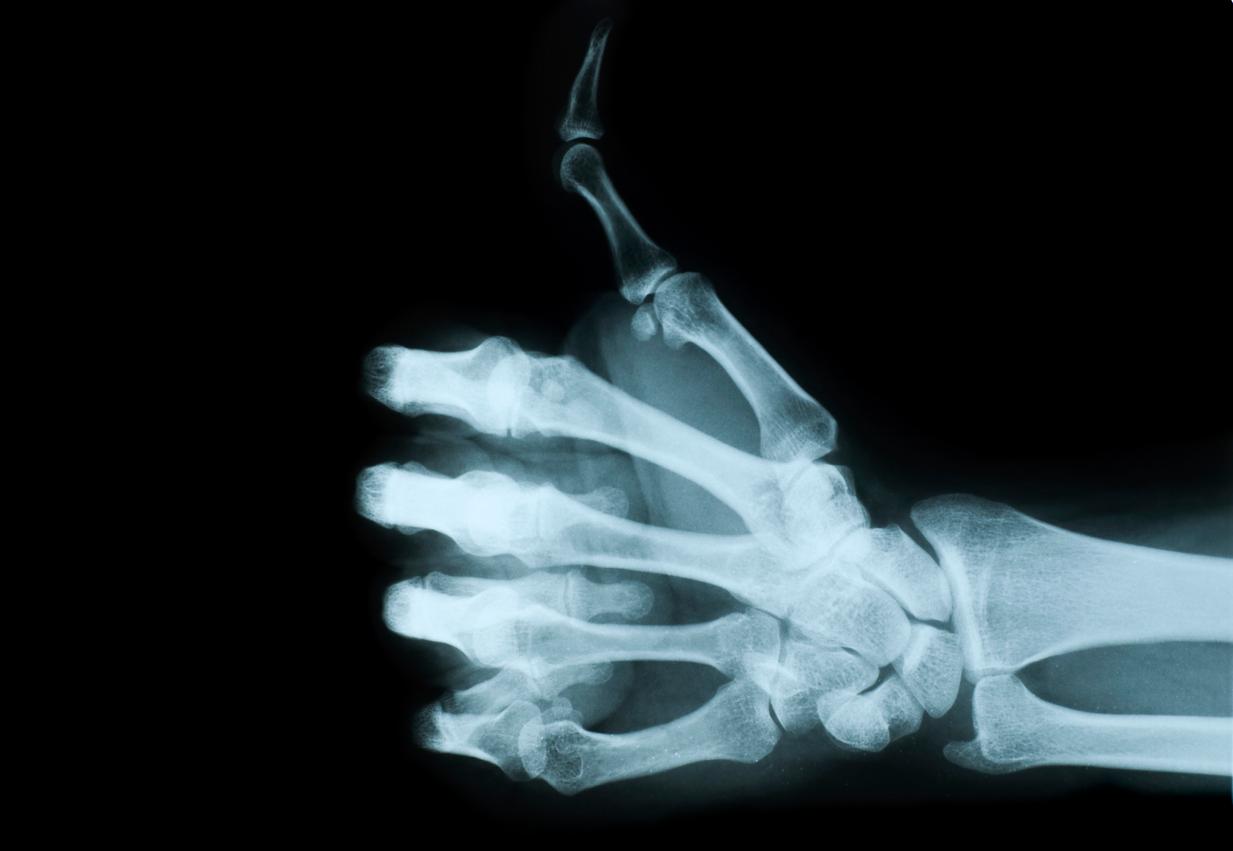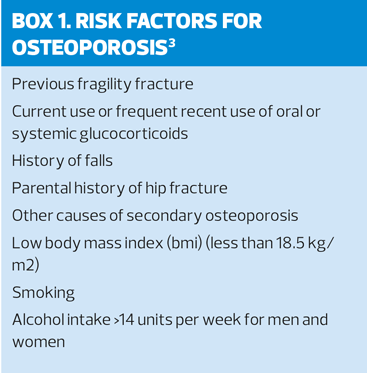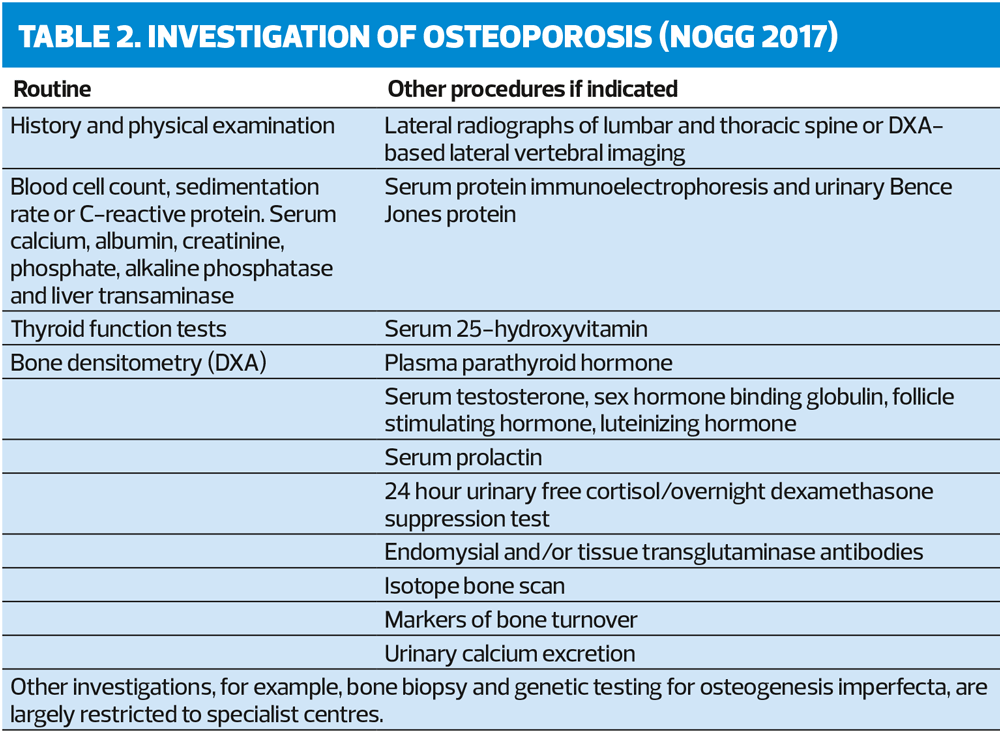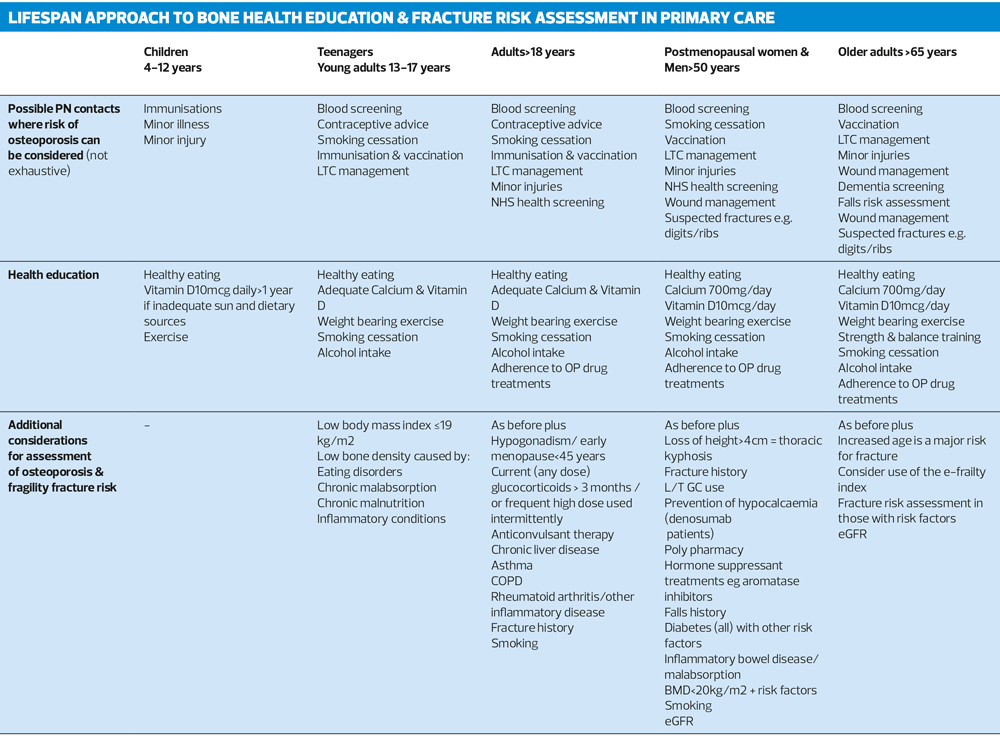
Prevention and management of osteoporosis in primary care
ROSE TOSON
ROSE TOSON
MSc Applied Ageing, Bachelor of Nursing, RDN, PG Dip HE (RNT)
Specialist Osteoporosis Nurse (information and support) at the National Osteoporosis Society and a Specialist Nurse Advisor to the Care Quality Commission
This expert guide explores the role of general practice nurses in the early identification of fracture risk, and the prevention and management of osteoporosis as well as lifestyle strategies for the maintenance of good bone health
Osteoporosis (meaning ‘porous bones’) is a condition in which bones lose strength and become more fragile. Bone is living tissue that is constantly renewing during the lifespan. In adults, small amounts of bone tissue are removed every day by osteoclast cells (the process of ‘resorption’) and must be equalled by deposits of bone by osteoblast cells in order to maintain strength. This process of continuous bone resorption and redeposition is called ‘bone remodelling’.
Osteoporosis occurs as a result of an imbalance in the bone remodelling process and as bone become more fragile, the risk of fractures increases. The World Health Organization1 defines osteoporosis as a ‘progressive systemic skeletal disease characterised by low bone mass and microarchitectural deterioration of bone tissue, with a consequent increase in bone fragility and susceptibility to fracture’.
FRAGILITY FRACTURES
Osteoporosis is clinically significant because of the occurrence of fragility fractures, which result from mechanical forces that would not ordinarily result in fracture, known as low-level (or ‘low energy’) trauma, equivalent to a fall from a standing height or less.2 The most common sites for fragility fracture are the spine (vertebrae), wrist (distal radius), and hip (proximal femur) although they may occur in the ribs, pelvis and other bones. Low bone density is a major risk factor for fragility fracture.
IMPACT
In the UK alone, more than one-in-two women and one-in-five men over the age of 50 are expected to break a bone in their lifetime.4
Fragility fractures can cause pain and kyphosis (spinal deformity), which in turn can affect respiratory and digestive functioning as well as continence. In turn, low mood, low self-esteem and an altered body image may result. Hip fractures may lead to disability, loss of independence and are associated with excess mortality. In addition, 50% of those who sustain a hip fracture do not subsequently return to their own home, thus placing a growing demand on health and social services.5
DIAGNOSIS
Osteoporosis diagnosis is based on the level of bone mass, measured as bone mineral density (BMD) on a dual energy X-ray absorptiometry (DXA) scan, and reported as a ‘T score’ – the standard deviations from the mean for young adult women. The diagnostic level of BMD is a T score of -2.5 or less.6 This was not intended as an intervention threshold for osteoporosis drug treatment although it has been commonly used in this way.
Assessment of fracture risk
Since factors affecting bone quality and strength are omitted, BMD value is not a true predictor of fracture risk. Many fragility fractures occur in women whose T score is > -2.5. Their bones bones may be a little thinner than usual (osteopenia) but they do not have osteoporosis as measured by BMD. However, bone therapy is required because a history of fragility fracture poses a significant risk of further fractures.
Other factors affecting bone quality and thus fracture risk are included in both the web based FRAX7 and QFracture8 risk assessment tools, enabling primary prevention of fractures i.e. early identification and treatment of those whose risk of a fragility fracture is high and secondary prevention of further fracture where a fracture has already occurred.
The FRAX risk assessment tool may be used for those aged 40-90 years, to predict fracture risk in the next 10 years, or to indicate when a DXA scan is required. A limitation of the FRAX tool is that it does not take account of duration of glucocorticord use, simply indicating risk associated with doses less than or greater than 7.5mg. Neither does it take account of the number or type of previous fragility fractures.
NICE3 advises risk assessment using either Frax or Qfracture for risk assessment prior to DXA scan. BMD values cannot subsequently be incorporated into the latter tool and for this reason, the National Osteoporosis Guideline Group (NOGG)6 recommends the FRAX tool. However, SIGN9 recommends Qfracture as it is considered to be more accurate at predicting fractures in the UK population than FRAX.
As in the use of all such risk assessment tools, the use of clinical judgement is imperative to ascertain an individual’s risk.
RISK FACTORS
NOGG6 advises that fracture risk should be considered in postmenopausal women and men >50 years who have risk factors. SIGN9 states that a DXA should be offered to those >50 who have had a fragility fracture, to evaluate the need for osteoporosis drug treatments.
Secondary causes
General practice nurses (GPNs) are ideally placed to be alert to both primary risk factors (Box 1) and potential secondary causes of osteoporosis in their routine work. Secondary causes include:
- Rheumatoid arthritis
- Untreated hypogonadism in men and women
- Prolonged immobility
- Organ transplantation
- Type 1 diabetes
- Hyperthyroidism
- Gastro intestinal disease
- Chronic liver disease
- Chronic obstructive pulmonary disease (COPD)
There is also some recent evidence that older adults with type 2 diabetes have a higher risk of fractures.10
Asthma patients are likely to regularly use inhaled corticosteroids (ICS) and may also be prescribed oral steroids to manage exacerbations. Patients with COPD may also be treated with oral steroids during exacerbations, or even permanently if their condition is advanced.
It is therefore essential that GPNs are aware of potential damage to bone caused by glucocorticoids (GCs). The exact dose that is harmful to bone varies between individuals, but research suggests that increased fracture risk can occur even with low doses (2.5-7.5mg prednisolone per day) and rises further with increasing daily doses.11
The length of time oral GCs are used is also significant. Most experts agree that if they are used continuously for more than 3 months, there can be an impact on bone, and this effect may be seen even earlier if very high doses are used. When GCs are used in low doses to replace what the body is not able to make (e.g. in Addison’s disease or pituitary disease), the overall health benefits of the glucocorticoids by far outweigh any potential small negative effect on bones and it is essential that they are taken as directed.
Asthma patients who require continuous or frequent use of oral steroids should be referred for specialist care,12 and assessed for osteoporosis risk.
COPD-associated osteoporosis is an often undertreated condition. A recent study suggested that both decreased (BMD) and impaired bone quality contribute to bone fragility, causing fractures in patients with COPD.13 Clinical risk factors for COPD-related osteoporosis include:13
- Older age
- Emaciation
- Physical insufficiency
- Vitamin D insufficiency
- Glucocorticoid use
Prevention of vertebral fractures in these patients is essential since their presence can lead to further impairment of respiratory function – postural change following a vertebral fracture can cause compression of the lungs.13 Although NICE15 does not recommend the use of maintenance doses of oral GCs in COPD, in advanced disease this may be necessary. In such cases, the dose should be kept as low as possible and the patient’s fracture risk should be monitored.
NOGG6 advises that those over 70 years with a previous fragility fracture or those taking high dose prednisolone (≥7.5mg daily) should be considered for drug treatment, which should be initiated for any individual at high risk of fracture when starting GC therapy. This is an important strategy for the prevention of glucocorticoid-induced osteoporosis.
As in the management of any chronic disease, if there is any doubt about the risks posed by a specific drug therapy, the advice of the appropriate specialist should be sought.
TREATMENT AND MANAGEMENT OF OSTEOPOROSIS
Lifestyle measures
Lifestyle measures to support bone health include adequate weight-bearing and resistance exercise such as walking. Stopping smoking, reducing alcohol consumption to no more than 14 units per week (for all), with some alcohol-free days, reducing falls risk and ensuring a well-balanced diet with adequate calcium and vitamin D intake are also important factors.
Although weight-bearing exercise may not on its own reduce fracture risk, it has beneficial effects on BMD.6 Strength and balance exercises have been shown to improve balance and coordination and improve confidence, thus helping to reduce falls risk. Physiotherapy is of recognised benefit in rehabilitation following fracture.
The Scientific Advisory Group on Nutrition15 now recommends a daily reference intake (RI) of 400IU (10mcg) of vitamin D for everyone over one year of age. However, for those 50 years and over, NOGG recommends 800iu (20mcg) daily for those at high risk of fracture.6
Adequate calcium intake is also essential (700mg–1000mg daily), preferably from dietary sources. There is little evidence for concerns that taking supplementary calcium can increase cardiovascular risk.16
Drug interventions
A number of drug treatments have been shown to be effective in reducing fracture risk in postmenopausal women with osteoporosis, and many are now also licensed for men. Recommendations based on high levels of evidence as summarised in Table 1 below.
Unlike NOGG guidance,6 which suggests drug treatment decisions should be based on overall ‘fracture risk’, SIGN states that drug treatments will only be effective in patients with a BMD T score of -2.5 or below.10
The oral bisphosphonates, alendronate and risedronate, are the most commonly used osteoporosis drug treatments in the UK. While they have been shown to be extremely effective at reducing fracture risk, both compliance and continuation are common problems.17 Oral bisphospohonates need to be taken first thing in the morning, on an empty stomach with no food, other medications or drink – other than water to swallow the tablet – for at least half an hour after taking the tablet. To prevent oesophageal irritation, it is important to remain upright (standing, sitting or walking) for a further 30 minutes. Poor understanding of this requirement, or a belief that other medications should be taken first, leads to poor absorption – and thus, poor effectiveness – and an increased risk of side effects.
Continuation is another issue since side effects or the fear of the rare adverse effect, osteonecrosis of the jaw, often lead patients to stopping treatment prematurely. It is therefore important that patients understand the risks and benefits associated with the drugs – both their use and non-use. Often, a discussion about this will help reduce anxiety and improve understanding of why the treatment has been prescribed. If a patient chooses not to take a drug treatment following this, strategies for promoting good bone health can be discussed (see below).
GPNs are well placed to discuss these issues with patients to improve adherence to treatment and to facilitate further assessment when a treatment is not tolerated.
In recent years, the prescribing of bisphosphonate treatments has changed, with greater emphasis now being placed on review of fracture risk. The risk of unusual (atypical) femur fracture associated with long term bisphosphonate treatment prompted the Medicines and Healthcare products Regulatory Agency (MHRA) to recommend review after approximately 5 years of bisphosphonate use.18 This means discussing whether the drugs are still needed, any side effects experienced and whether the benefit of continuing them outweighs potential harm. Because these drugs continue to provide some bone protection even after they are stopped, it may be that their use can be ‘paused’ for 2–3 years, before a further fracture risk assessment. Such a pause would not be considered where fragility fractures have occurred, especially in the spine or hip, or when the risk of fractures is considered high. In such cases, the benefits of continued treatment are far greater than the low risk of atypical femur fractures.
This approach applies only to the prolonged use of bisphosphonate treatments, and not to other bone therapies such as denosumab (Prolia). Denosumab has a different mode of action and leaves the body quickly when stopped, thus rapidly diminishing bone protection. In the absence of a replacement therapy, fracture risk will quickly increase again.
Prevention of hypocalcaemia is an important consideration in the administration of this particular drug. Blood tests should be performed two weeks prior to drug administration to check that calcium and vitamin D levels are replete, and it is also important that the drug is administered regularly, every 6 months, to avoid loss of bone protection.
As commissioning of services evolve, GPNs are becoming increasingly involved in the administration of denosumab so it is important these issues are understood and addressed.
ROLE OF THE GPN
General practice nurses have a unique role to play in the prevention, identification, assessment and management of osteoporosis in their practice population, both opportunistically and on a planned basis. This role applies across the age spectrum in all aspects of the role. Specifically, they can influence:
- Education on healthy living for strong bones
- Identification of fracture risk in the practice population.
NICE3 suggests that because GP records are universally computerised, they may be useful in identifying patients at high risk of fracture. In secondary care, early identification of risk is being pursued by Fracture Liaison Services, championed by the National Osteoporosis Society. In primary care, this may be done as a systematic audit of at risk groups such as women who experienced an early menopause, those on anticonvulsant or steroid medications, those with long term health conditions and those with a history of non-traumatic fracture.
Although SIGN10 uses FRAX to see who needs a BMD scan and thus will benefit from a treatment, this isn’t the NOGG approach – NOGG6 only uses BMD if there is uncertainty about whether fracture risk is high – BMD isn’t needed before treatment. Either approach is of use in identifying those at high fracture risk.
- Improving compliance and persistence with treatment regimes and reiterating the importance of treatment reviews
Opportunities for GPNs to use a ‘lifespan approach’ to bone health education and fracture risk assessment are described in the table on the previous page.
DID YOU KNOW?
- It is estimated that every year in the UK, there are more than 500,000 fragility fractures; that’s one every minute (1400 per day)20
- Fracture risk is doubled in the presence of a previous fracture; this risk increases further if the previous fracture was a spinal one6
- A survey by the National Osteoporosis Society (NOS) identified that one fifth of women who have broken a bone, break three or more before being diagnosed20
- It is now recommended that everyone in the UK general population aged 1 years and older should have a RNI of 10 micrograms of vitamin D daily, throughout the year if they do not get adequate sunshine and dietary vitamin D14
- Taking calcium supplements within 4 hours of taking a bisphosphonate will reduce the absorption of the bisphosphonate21
- People on denosumab (Prolia) or zoledronic acid (Aclasta) treatments for osteoporosis may be at risk of hypocalcaemia since rarely, these drugs can cause blood calcium levels to drop significantly. Blood tests to assess calcium and vitamin D levels prior to each treatment are required22
- Unlike bisphosphonates, denosumab leaves the body quite quickly when treatment is stopped and so benefits gained may be lost. It is essential that those on this treatment have a medical review of their fracture risk promptly if it is discontinued
- Strontium ranelate is being discontinued as of August 2017. Patients currently receiving this treatment should have their fracture risk reviewed to determine future management options.
REFERENCES
1. World Health Organization Study Group (1994) in Leyland. S Assessing fracture risk and preventative strategies in older people. Nurse Prescribing 2013;11(11):554
2. Jonell O, Kanis JA, Oden A, et al. Fracture risk following an osteoporotic fracture Osteoporosis International 2004;15(3):175-9
3. NICE CG146. Osteoporosis: assessing the risk of fragility fracture, 2017. https://www.nice.org.uk/guidance/cg146
4.Van Staa TP, Dennison EM, Cooper C. Epidemiology of fractures in England and Wales.Bone.2001;29(6):517-22
5. Royal College of Physicians. National Hip Fracture Database extended report, 2016.http://www.nhfd.co.uk
6. National Osteoporosis Guideline Group. Clinical guideline for the prevention and treatment of osteoporosis, 2017 www.shef.ac.uk/NOGG
7. Kanis JA, Johnell O, Oden A, Mccloskey E. FRAX and the assessment of fracture probability in men and women from the UK. Osteoporosis International 2008;19(4) 385-97 doi:10.1007/s00198-007-0543-5
8. Hippisley-Cox J, Coupland C. Predicting risk of osteoporotic fracture in men and women in England and Wales: prospective derivation and validation of Qfracture Scores. BMJ 2009;339:b4229. http://www.bmj.com/content/339/bmj.b4229
9. SIGN 142. Management of osteoporosis and the prevention of fragility fractures, 2015. http://www.sign.ac.uk/sign-142-management-of-osteoporosis-and-the-prevention-of-fragility-fractures.html
10. Rubin MR, Schwartz AV, Kanis JA, et al. Osteoporosis Risk in Type 2 Diabetes Patients. Expert Rev Endocrinol Metab. 2013;8(5):423-425. http://www.tandfonline.com/doi/full/10.1586/17446651.2013.835567
11. National Osteoporosis Society. Glucocorticoids and osteoporosis, 2014.
https://nos.org.uk/media/1582/glucocorticoids-steroids-and-osteoporosis-august-2014.pdf
12. SIGN 123 (2016) British guideline on the management of asthma
at http://www.sign.ac.uk/pdf/SIGN153.pdf
13. Inoue D, Watanabe R, Kkazaki R. COPD and osteoporosis: links, risks, and treatment challenges Int J Chron Obstruct Pulmon Dis. 2016;11:637–648 https://www.ncbi.nlm.nih.gov/pmc/articles/PMC4820217/#
14. NICE CG101. Chronic obstructive pulmonary disease in the over 16s: diagnosis and management, 2010 https://www.nice.org.uk/guidance/cg101
15. Scientific Advisory Committee on Nutrition and Health. Vitamin D and Health, 2016. https://www.gov.uk/government/groups/scientific-advisory-committee-on-nutrition
16. Lewis JR, Radavelli-Bagatini S, Rejnmark L, et al. The effects of calcium supplementation on verified coronary heart disease hospitalization and death in postmenopausal women: a collaborative meta-analysis of randomized controlled trials. J Bone Miner Res 2015;30:165-75.
17. Cramer JA, Roy A, Burrell A, et al, (2008) Medication Compliance and Persistence: Terminology and Definitions Value in Health 2008;11(1):3-12
18. MHRA. Bisphosphonates: osteonecrosis of the jaw, 2009. https://www.gov.uk/drug-safety-update/bisphosphonates-osteonecrosis-of-the-jaw
19. Svedbom A, Hernlund E, Ivergard M et al EU Review Panel of IOF (2013) Osteoporosis in the European Union, : a compendium of country-specific reports. Arch Osteoporos 2013;8(12):137
20. National Osteoporosis Society Stop at One Survey (2013) National Osteoporosis Society
21. EMC. AdCalD3 Summary of Product Characterisistics, 2017
22. EMC Denosumab Summary of Product Characterisistics, 2017
Related articles
View all Articles





